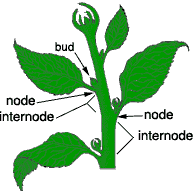The two most common natural tree forms are:
- "Excurrent" - where the trunk of the tree is uninterrupted from the ground to the top and has a number of smaller limbs extending horizontally from the tree trunk, as shown in Figure 5. This creates a slender form.
- "Deliquescent" or "decurrent" - where the trunk of the tree divides into large limbs which creates an umbrella shaped form, as shown in Figure 6.
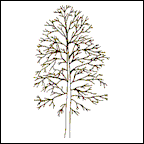
Figure 5 - Excurrent tree form
Excurrent trees are pyramid in shape and is the common shape of most conifer trees.
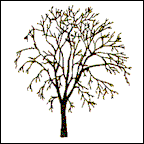
Figure 6 - Deliquescent or decurrent tree form
Deliquescent trees are spherical in shape and is the common shape of most hardwood trees.
It is best to always prune an ornamental or shade tree to its natural form. If one attempts to prune a tree to a different shape than its natural form it could damage the tree and will require continuous pruning throughout its life.
In some cases it is necessary to prune a tree completely outside of its natural form. There are two primary examples of severe tree pruning:
- Pollarding is a pruning method whereby all of the limbs of a tree are removed, as shown in Figure 7. This provides for a complete set of new tree limbs to grow at the ends of the cut limbs. In some cases this is a yearly exercise.
- Topiary pruning is when a tree or shrub is shaped to appear as a specific object or animal, as shown in Figure 8.
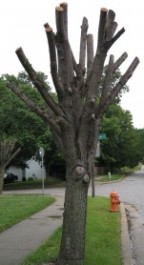
Figure 7 - Tree pollard pruned
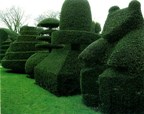
Figure 8 - Topiary tree pruning
These types of severe tree pruning, pollarding and topiary, must be done with care, while, as the figures show, it is possible to shape an ornamental or shade tree into almost any shape desired, pruning at the wrong time of year and/or pruning incorrectly can easily kill the tree.
It should be noted that pollarding and topiary pruning takes a lot of knowledge and skill and should be only done on the advise and supervision of professionals.
- Fruit Production Stimulation:
- Lumber Yield:
Proper pruning of fruit trees will enhance the production of fruit, not only in quantity but in quality as well. Figure 9 shows a Peach tree that has been pruned on its left side only.
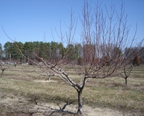
Figure 9 - Partially pruned Peach tree
A homeowner should discuss specific pruning of fruit trees with an expert in the field.
Although not generally a concern of homeowners, proper pruning of large trees will multiply the yield and quality of useable lumber that can be obtained once the tree is harvested.
Pruning Methodology:
With young trees the homeowner should be pruning with the goal of creating a well-built tree structure. Once the tree has reached a level of maturity the homeowner should be pruning the tree with the goals of aesthetics, health, and form.
All pruning should take place at tree nodes. A node is the spot at which a tree limb, branch or twig connects to another tree limb, branch or twig. Buds will begin to appear in the spring of each year creating or forming new nodes. The distance between nodes is termed the internode. Figure 10 shows the positioning of the buds, nodes and internodes on a tree.
